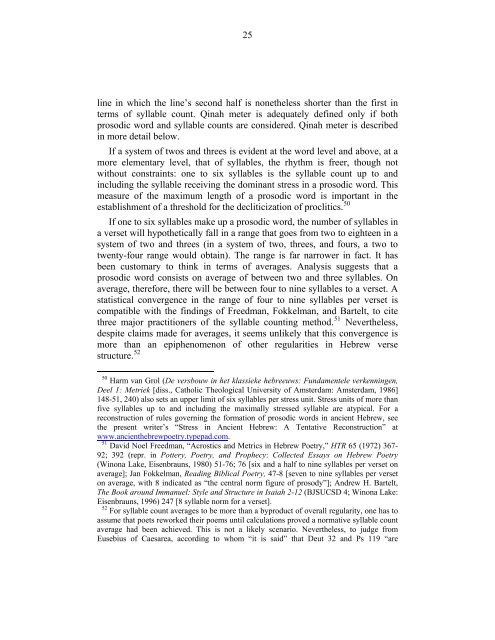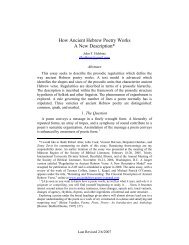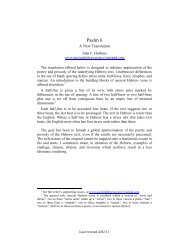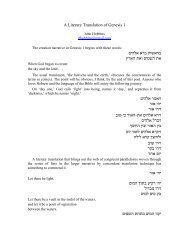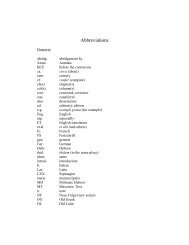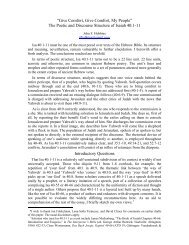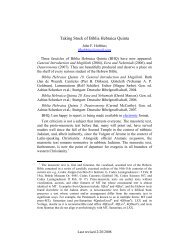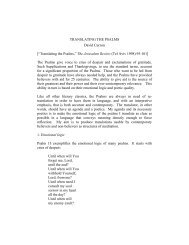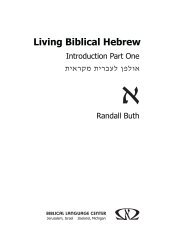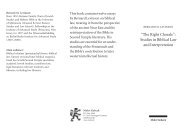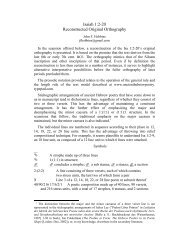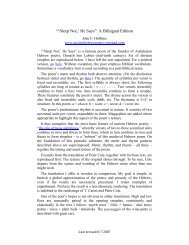Here - Ancient Hebrew Poetry - Typepad
Here - Ancient Hebrew Poetry - Typepad
Here - Ancient Hebrew Poetry - Typepad
- No tags were found...
You also want an ePaper? Increase the reach of your titles
YUMPU automatically turns print PDFs into web optimized ePapers that Google loves.
25line in which the line’s second half is nonetheless shorter than the first interms of syllable count. Qinah meter is adequately defined only if bothprosodic word and syllable counts are considered. Qinah meter is describedin more detail below.If a system of twos and threes is evident at the word level and above, at amore elementary level, that of syllables, the rhythm is freer, though notwithout constraints: one to six syllables is the syllable count up to andincluding the syllable receiving the dominant stress in a prosodic word. Thismeasure of the maximum length of a prosodic word is important in theestablishment of a threshold for the decliticization of proclitics. 50If one to six syllables make up a prosodic word, the number of syllables ina verset will hypothetically fall in a range that goes from two to eighteen in asystem of two and threes (in a system of two, threes, and fours, a two totwenty-four range would obtain). The range is far narrower in fact. It hasbeen customary to think in terms of averages. Analysis suggests that aprosodic word consists on average of between two and three syllables. Onaverage, therefore, there will be between four to nine syllables to a verset. Astatistical convergence in the range of four to nine syllables per verset iscompatible with the findings of Freedman, Fokkelman, and Bartelt, to citethree major practitioners of the syllable counting method. 51 Nevertheless,despite claims made for averages, it seems unlikely that this convergence ismore than an epiphenomenon of other regularities in <strong>Hebrew</strong> versestructure. 5250 Harm van Grol (De versbouw in het klassieke hebreeuws: Fundamentele verkenningen,Deel 1: Metriek [diss., Catholic Theological University of Amsterdam: Amsterdam, 1986]148-51, 240) also sets an upper limit of six syllables per stress unit. Stress units of more thanfive syllables up to and including the maximally stressed syllable are atypical. For areconstruction of rules governing the formation of prosodic words in ancient <strong>Hebrew</strong>, seethe present writer’s “Stress in <strong>Ancient</strong> <strong>Hebrew</strong>: A Tentative Reconstruction” atwww.ancienthebrewpoetry.typepad.com.51 David Noel Freedman, “Acrostics and Metrics in <strong>Hebrew</strong> <strong>Poetry</strong>,” HTR 65 (1972) 367-92; 392 (repr. in Pottery, <strong>Poetry</strong>, and Prophecy: Collected Essays on <strong>Hebrew</strong> <strong>Poetry</strong>(Winona Lake, Eisenbrauns, 1980) 51-76; 76 [six and a half to nine syllables per verset onaverage]; Jan Fokkelman, Reading Biblical <strong>Poetry</strong>, 47-8 [seven to nine syllables per verseton average, with 8 indicated as “the central norm figure of prosody”]; Andrew H. Bartelt,The Book around Immanuel: Style and Structure in Isaiah 2-12 (BJSUCSD 4; Winona Lake:Eisenbrauns, 1996) 247 [8 syllable norm for a verset].52 For syllable count averages to be more than a byproduct of overall regularity, one has toassume that poets reworked their poems until calculations proved a normative syllable countaverage had been achieved. This is not a likely scenario. Nevertheless, to judge fromEusebius of Caesarea, according to whom “it is said” that Deut 32 and Ps 119 “are


